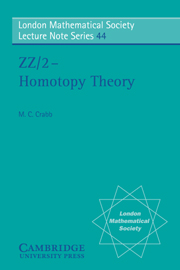Book contents
- Frontmatter
- Contents
- Acknowledgments
- 1 Introduction
- 2 The Euler class and obstruction theory
- 3 Spherical fibrations
- 4 Stable cohomotopy
- 5 Framed manifolds
- A Appendix: On the Hopf invariant
- 6 K-theory
- 7 The image of J
- 8 The Euler characteristic
- 9 Topological Hermitian K-theory
- 10 Algebraic Hermitian K-theory
- B Appendix: On the Hermitian J-homomorphism
- Bibliography
- Index
B - Appendix: On the Hermitian J-homomorphism
Published online by Cambridge University Press: 23 March 2010
- Frontmatter
- Contents
- Acknowledgments
- 1 Introduction
- 2 The Euler class and obstruction theory
- 3 Spherical fibrations
- 4 Stable cohomotopy
- 5 Framed manifolds
- A Appendix: On the Hopf invariant
- 6 K-theory
- 7 The image of J
- 8 The Euler characteristic
- 9 Topological Hermitian K-theory
- 10 Algebraic Hermitian K-theory
- B Appendix: On the Hermitian J-homomorphism
- Bibliography
- Index
Summary
In homotopy theory the distinction between real vector bundles and complex bundles with a non-singular symmetric form – the real orthogonal group O(n) is a maximal compact subgroup in both GL(n, ℝ) and O(n, ℂ) – is a subjective rather than a material one. (This is not true in differential geometry. Consider a smooth complex vector bundle of even dimension with a smooth non-singular symmetric form and a compatible connection. Then the Pfaffian of the curvature represents the Euler class, in de Rham cohomology, of the associated, homotopy-theoretic, real vector bundle. If the connection is flat, then the rational Euler class is zero. On the other hand, there are flat real vector bundles with non-vanishing rational Euler class.) In the context of the J-homomorphism, nevertheless, the Hermitian standpoint seems to be preferred to the Real. We redress the balance of §6.
As far as homotopy theory is concerned a non-singular ∈-symmetric (∈ = +1 or −1) form on a complex vector bundle µ over a compact ℤ/2-ENR X is a conjugate linear bundle map j : µ → µ covering the involution on X and such that j2 = ∈. The symmetric form is recovered, by choosing an invariant Kermitian metric 〈−, −〉, as. (See (9.1).)
We begin with the local obstruction. Let V be a complex vector space with conjugate linear structure map j, j2 = ∈, and invariant metric.
- Type
- Chapter
- Information
- ZZ/2 - Homotopy Theory , pp. 115 - 120Publisher: Cambridge University PressPrint publication year: 1980



